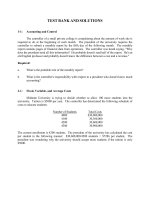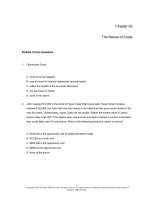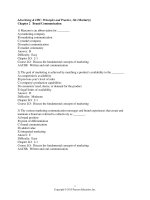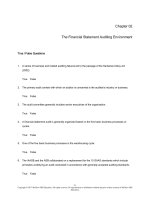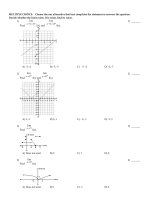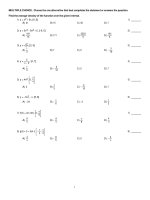Nutrition for health fitness and sport 10th edition williams test bank
Bạn đang xem bản rút gọn của tài liệu. Xem và tải ngay bản đầy đủ của tài liệu tại đây (101.34 KB, 38 trang )
Chapter 02 - Healthful Nutrition for Fitness and Sport: The Consumer Athlete
Chapter 02
Healthful Nutrition for Fitness and Sport: The Consumer Athlete
Multiple Choice Questions
1. The three key words to a healthful diet are balance, variety, and
A. availability.
B. moderation.
C. quality.
D. complementarity.
Bloom's Level: 1. Remember
Learning Objective: 02-03
Question Type: Multiple Choice
Topic: Nutrition Basics
2. Nutrients that the body needs, but cannot produce in adequate quantities are called
A. essential nutrients.
B. dispensable nutrients.
C. nonessential nutrients.
D. nondispensable nutrients.
Bloom's Level: 1. Remember
Learning Objective: 02-01
Question Type: Multiple Choice
Topic: Nutrition Basics
3. Macronutrients
A. may provide energy but do not support growth and development of body tissues.
B. have a daily requirement that is less than a few grams.
C. include carbohydrates, fats, and proteins, as well as water.
D. contain no Calories.
Bloom's Level: 1. Remember
Learning Objective: 02-01
Question Type: Multiple Choice
Topic: Nutrition Basics
2-1
Chapter 02 - Healthful Nutrition for Fitness and Sport: The Consumer Athlete
4. One example of a micronutrient is
A. water.
B. minerals.
C. carbohydrate.
D. fat.
Bloom's Level: 1. Remember
Learning Objective: 02-01
Question Type: Multiple Choice
Topic: Nutrition Basics
5. A good example of a nonessential nutrient is
A. fiber.
B. calcium.
C. niacin.
D. creatine.
Bloom's Level: 1. Remember
Learning Objective: 02-01
Question Type: Multiple Choice
Topic: Nutrition Basics
6. MyPlate stresses all but which one of the following:
A. Weight loss
B. Variety
C. Activity
D. Personalization
Bloom's Level: 2. Understand
Learning Objective: 02-03
Question Type: Multiple Choice
Topic: Healthy Diet Guidelines
2-2
Chapter 02 - Healthful Nutrition for Fitness and Sport: The Consumer Athlete
7. One of the nutrients included in the Key Nutrient concept is
A. vitamin D.
B. vitamin E.
C. potassium.
D. calcium.
Bloom's Level: 1. Remember
Learning Objective: 02-01
Question Type: Multiple Choice
Topic: Healthy Diet Guidelines
8. Nutrient density
A. is an important concept based on food processing and fortification.
B. will automatically increase simply by increasing the amount of dietary fat and sugar.
C. is when a food possesses a significant amount of specific nutrients per serving relative to
its caloric content.
D. is an indicator of food irradiation.
Bloom's Level: 1. Remember
Learning Objective: 02-04
Question Type: Multiple Choice
Topic: Healthy Diet Guidelines
9. When considering the key-nutrient concept, which of the following is NOT true?
A. The theory is based on the eight nutrients central to human nutrition
B. Highly processed foods to which some vitamins have been added are acceptable to this
concept
C. If the key nutrients are adequate in your diet, you will probably receive an ample supply of
all nutrients essential to humans
D. The Food Exchange Lists can be a useful guide to securing the key nutrients, if one keeps
in mind that there is some variation in the proportion of the nutrients within each food
exchange
Bloom's Level: 2. Understand
Learning Objective: 02-01
Question Type: Multiple Choice
Topic: Healthy Diet Guidelines
2-3
Chapter 02 - Healthful Nutrition for Fitness and Sport: The Consumer Athlete
10. Which of the following statements about the Food Exchange System is correct?
A. It is a food guide, but it is dissimilar to MyPlate
B. It was developed by the American Dietetic Association and American Diabetic Association,
as well as other health organizations
C. It was developed specifically for prevention of cardiovascular disease
D. It includes eight exchanges that contain approximately the same amount of Calories,
carbohydrate, fat, and protein
Bloom's Level: 1. Remember
Learning Objective: 02-01
Question Type: Multiple Choice
Topic: Healthy Diet Guidelines
11. Which statement about the typical American diet is FALSE?
A. Americans eat too much saturated fat
B. Americans eat too many Calories
C. Americans obtain adequate amounts of calcium
D. Americans do not eat enough fiber-rich foods
Bloom's Level: 1. Remember
Learning Objective: 02-03
Question Type: Multiple Choice
Topic: Healthy Diet Guidelines
12. According to the Prudent Healthy Diet guidelines, the recommended dietary goal for fat
Calories is less than _____ percent of the total daily Calories.
A. 40
B. 30
C. 20
D. 10
Bloom's Level: 1. Remember
Learning Objective: 02-05
Question Type: Multiple Choice
Topic: Healthy Diet Guidelines
2-4
Chapter 02 - Healthful Nutrition for Fitness and Sport: The Consumer Athlete
13. The recommended daily dietary goal for cholesterol intake is no more than
A. 150mg.
B. 200mg.
C. 250mg.
D. 300mg.
Bloom's Level: 1. Remember
Learning Objective: 02-05
Question Type: Multiple Choice
Topic: Healthy Diet Guidelines
14. When considering the types of food a vegetarian eats, which of the following is true?
A. Semivegetarians do not eat meat such as fish and poultry
B. Ovovegetarians will eat both egg and milk products
C. Vegans will eat fish and poultry, but will eat no red meat
D. Lactovegetarians will include foods in the milk group in their diets
Bloom's Level: 1. Remember
Learning Objective: 02-06
Question Type: Multiple Choice
Topic: Healthy Diet Guidelines
15. If foods are not selected carefully, strict vegetarians may incur nutritional deficiencies
involving
A. vitamin A.
B. vitamin C.
C. calcium.
D. potassium.
Bloom's Level: 1. Remember
Learning Objective: 02-06
Question Type: Multiple Choice
Topic: Healthy Diet Guidelines
2-5
Chapter 02 - Healthful Nutrition for Fitness and Sport: The Consumer Athlete
16. To obtain protein complementarity, you would combine rice with
A. wheat.
B. oats.
C. corn.
D. soybeans.
Bloom's Level: 1. Remember
Learning Objective: 02-06
Question Type: Multiple Choice
Topic: Healthy Diet Guidelines
17. Of the following statements, which is true of a healthy vegetarian diet?
A. It is always healthier than a diet that includes foods in the meat and milk groups
B. The major nutritional difference between a nonvegetarian and a vegetarian diet appears to
be the higher content of saturated fats and cholesterol in the latter
C. It supplies more than an adequate amount of nutrients and is rather low in caloric content
D. Vitamin B12 deficiencies are very rare with a pure vegetarian diet
Bloom's Level: 1. Remember
Learning Objective: 02-06
Question Type: Multiple Choice
Topic: Healthy Diet Guidelines
18. What is the term used to describe the average daily dietary intake that is sufficient to meet
the nutrient requirement of nearly all healthy individuals?
A. Tolerable Upper Intake Limit (UL)
B. Estimated Average Requirement (EAR)
C. Adequate Intake (AI)
D. Recommended Dietary Allowance (RDA)
Bloom's Level: 1. Remember
Learning Objective: 02-02
Question Type: Multiple Choice
Topic: Nutrition Basics
2-6
Chapter 02 - Healthful Nutrition for Fitness and Sport: The Consumer Athlete
19. What is the term used to describe the recommended daily nutrient intake level based on
observed or experimentally determined approximations of nutrient intake by a group of
healthy people?
A. Tolerable Upper Limit (UL)
B. Estimated Average Requirement (EAR)
C. Adequate Intake (AI)
D. Recommended Dietary Allowance (RDA)
Bloom's Level: 1. Remember
Learning Objective: 02-02
Question Type: Multiple Choice
Topic: Nutrition Basics
20. The Dietary Reference Intake (DRI) consists of which of the following reference intakes?
A. RDA and AI
B. RDA and UL
C. RDA, AI and UL
D. RDA, AI, UL and EAR
Bloom's Level: 1. Remember
Learning Objective: 02-02
Question Type: Multiple Choice
Topic: Nutrition Basics
21. Which of the following is an optional listing on a Nutrition Facts Label?
A. Amount per serving of total fat
B. Amount per serving of Calcium
C. Amount per serving of all B vitamins
D. Amount per serving of saturated fat
Bloom's Level: 1. Remember
Learning Objective: 02-07
Question Type: Multiple Choice
Topic: Nutrition Basics
2-7
Chapter 02 - Healthful Nutrition for Fitness and Sport: The Consumer Athlete
22. Food manufacturers may make health claims under the new labeling regulations
A. because the FDA believes that there may be sufficient scientific data supporting a
relationship between consumption of a specific nutrient and possible prevention of certain
chronic diseases.
B. if the degree of risk reduction is stated in specific terms.
C. and currently five such claims are allowed.
D. if the food is considered a functional food.
Bloom's Level: 2. Understand
Learning Objective: 02-07
Question Type: Multiple Choice
Topic: Nutrition Basics
23. When the body cannot properly digest a portion of food resulting in gastrointestinal
distress, you are most likely suffering from
A. food poisoning.
B. food allergy.
C. foodborne illness.
D. food intolerance.
Bloom's Level: 2. Understand
Learning Objective: 02-10
Question Type: Multiple Choice
Topic: Human Digestion and Absorption
24. Which of the following is true about food processing and its impact on food quality?
A. We consume many totally synthetic products, but additives and supplements give them the
same nutrient value as their natural counterparts
B. Research suggests that home processing may actually cause less nutrient loss than
commercial preservation
C. Niacin and vitamin K may be seriously depleted by food processing
D. The major problem with food processing is the excessive use of highly refined products
and questionable additives
Bloom's Level: 2. Understand
Learning Objective: 02-09
Question Type: Multiple Choice
Topic: Nutrition Basics; Food Supply
2-8
Chapter 02 - Healthful Nutrition for Fitness and Sport: The Consumer Athlete
25. A food that is "low in saturated fat" contains:
A. Only unsaturated fats
B. <20 grams of fat per serving and not more than 15% of kilocalories from saturated fatty
acids
C. <1 gram of fat per serving and not more than 15% of kilocalories from trans-fatty acids
D. <1 gram of fat per serving and not more than 15% of kilocalories from saturated fatty acids
Bloom's Level: 1. Remember
Learning Objective: 02-07
Question Type: Multiple Choice
Topic: Healthy Diet Guidelines
26. In general, a solid precompetition meal should
A. be eaten about two hours prior to competition.
B. be high in carbohydrate and low in fat and protein, providing for easy digestibility.
C. restrict fluid intake in order to prevent body water retention.
D. contribute to a reverse osmotic effect.
Bloom's Level: 1. Remember
Learning Objective: 02-09
Question Type: Multiple Choice
Topic: Nutrition Basics; Sports and Exercise Nutrition
27. Which of the following foods would make a good choice to include in a precompetition
meal?
A. Oatmeal
B. Beans
C. Bran products
D. Spicy shrimp casserole
Bloom's Level: 1. Remember
Learning Objective: 02-11
Question Type: Multiple Choice
Topic: Sports and Exercise Nutrition
2-9
Chapter 02 - Healthful Nutrition for Fitness and Sport: The Consumer Athlete
28. A breakfast
A. that is balanced and high in refined carbohydrates will help prevent the onset of
mid-morning hunger.
B. with only an average amount of protein may trigger an insulin response and produce
hypoglycemia in the middle of the morning.
C. that is balanced may be especially important for the physically active individual.
D. that is high in saturated fat is bets to fuel mid-day physical activity.
Bloom's Level: 3. Apply
Learning Objective: 02-11
Question Type: Multiple Choice
Topic: Sports and Exercise Nutrition
29. A food that is "low sodium" contains:
A. <5 milligrams per serving
B. 140 milligrams or less of sodium per serving
C. At least 50% less sodium per serving than the reference food
D. At least 25% or less sodium per serving than the reference food
Bloom's Level: 1. Remember
Learning Objective: 02-07
Question Type: Multiple Choice
Topic: Nutrition Basics
30. Which of the following is true concerning diet and competition?
A. There is no need to consume anything during most types of athletic competition with the
possible exception of electrolytes and water
B. On the day following competition, carbohydrate loading is prudent so muscle glycogen
will be replaced more quickly
C. Those individuals involved in daily physical activity of a prolonged nature should stress
complex carbohydrate foods in their daily diet
D. Those individuals involved in athletic competition or prolonged daily physical activity
have no need to consume anything except electrolytes and water during competition, but do
need to stress complex carbohydrate foods in a daily diet
Bloom's Level: 3. Apply
Learning Objective: 02-11
Question Type: Multiple Choice
Topic: Sports and Exercise Nutrition
2-10
Chapter 02 - Healthful Nutrition for Fitness and Sport: The Consumer Athlete
31. Antioxidant nutrients and phytochemicals that may provide a medical or health benefit are
referred to, collectively, as
A. pharmaceuticals.
B. nutraceuticals.
C. saturated fats.
D. enzymes.
Bloom's Level: 1. Remember
Learning Objective: 02-06
Question Type: Multiple Choice
Topic: Nutrition Basics
32. Of the following, vegetarian diets normally are least likely to contain inadequate amounts
of
A. fiber.
B. vitamin B-12.
C. calcium.
D. iron.
Bloom's Level: 2. Understand
Learning Objective: 02-06
Question Type: Multiple Choice
Topic: Healthy Diet Guidelines
33. Which of the following statements regarding dietary supplements is FALSE?
A. Dietary supplements may be harmful if individuals use them as substitutes for a healthy
diet
B. Health claims listed on the label have been substantiated by the Food and Drug
Administration (FDA)
C. Dietary supplements of the same product, such as ginseng, may vary greatly in quality
D. Dietary supplements may actually impair one's health, and may even be fatal, when used
improperly
E. In some countries, dietary supplements are regulated as drugs
Bloom's Level: 2. Understand
Learning Objective: 02-08
Question Type: Multiple Choice
Topic: Nutrition Basics
2-11
Chapter 02 - Healthful Nutrition for Fitness and Sport: The Consumer Athlete
34. Which of the following is not one of the classes of dietary supplements documented in the
DSHEA?
A. Herbals and botanicals
B. Vitamins
C. Amino acids
D. Minerals
E. Alcohol
Bloom's Level: 1. Remember
Learning Objective: 02-08
Question Type: Multiple Choice
Topic: Nutrition Basics
35. Approximately how many Calories are in a meal with 2 starch/bread exchanges, 4 very
lean meat exchanges, 1 fruit exchange, 1 vegetable exchanges, 2 fat exchanges and 1 skim
milk exchange?
A. 420
B. 490
C. 565
D. 715
E. 780
Bloom's Level: 3. Apply
Learning Objective: 02-05
Question Type: Multiple Choice
Topic: Nutrition Basics
36. How many Calories are in a Whopper sandwich, a large order of French fries, and a
medium soft drink if this meal contains 25 grams of protein, 80 grams of carbohydrate, and 40
grams of fat?
A. 686
B. 780
C. 911
D. 1,066
E. 1,140
Bloom's Level: 3. Apply
Learning Objective: 02-01
Question Type: Multiple Choice
Topic: Nutrition Basics
2-12
Chapter 02 - Healthful Nutrition for Fitness and Sport: The Consumer Athlete
37. An order of Chicken McNuggets has 314 Calories and 19 grams of fat. What percentage
of this meal is composed of fat Calories?
A. 26
B. 35
C. 44
D. 54
E. 66
Bloom's Level: 3. Apply
Learning Objective: 02-01
Question Type: Multiple Choice
Topic: Nutrition Basics
38. Compared to skim milk, a glass of whole milk contains about an additional seven grams
of fat. How many additional Calories does this represent?
A. 16
B. 28
C. 63
D. 95
E. 120
Bloom's Level: 3. Apply
Learning Objective: 02-01
Question Type: Multiple Choice
Topic: Nutrition Basics
39. The current USDA MyPlate Guide is based on the following food groups:
A. Grains, vegetables, fruits, proteins, dairy
B. Grains, vegetables, fruits, dairy, proteins, sweets
C. Grains, vegetables, fruits, oils, proteins
D. Vegetables, fruit, oils, dairy
Bloom's Level: 1. Remember
Learning Objective: 02-03
Question Type: Multiple Choice
Topic: Healthy Diet Guidelines
2-13
Chapter 02 - Healthful Nutrition for Fitness and Sport: The Consumer Athlete
40. Which of the following is NOT an acceptable definition for food labels with the listing
"free"?
A. Fat free-less than 0.5 grams of total fat per serving
B. Cholesterol free-less than 2 milligrams per serving
C. Sugar free-less than 5 grams per serving
D. Calorie free-less than 5 Calories per serving
E. Sodium free-less than 5 milligrams per serving
Bloom's Level: 1. Remember
Learning Objective: 02-07
Question Type: Multiple Choice
Topic: Nutrition Basics
41. Which of the following is NOT a recommended dietary guideline associated with the
Prudent Healthy Diet?
A. Maintain a healthy body weight
B. Eat a variety of wholesome, natural foods
C. Choose a diet with plenty of complex carbohydrates
D. Choose a diet low in fat and saturated fat
E. Take a daily one-a-day multivitamin/mineral tablet with at least twice the RDA for all
vitamins and minerals
Bloom's Level: 2. Understand
Learning Objective: 02-05
Question Type: Multiple Choice
Topic: Nutrition Basics
42. The Daily Values (DV) on food labels are based on certain dietary recommendations for
Americans. Which of the following does not currently serve as a basis for the determination
of the DV on the food label?
A. Maximum of 30% of total fat Calories
B. Maximum of 10% of saturated fat Calories
C. Minimum of 60% carbohydrate Calories
D. Less than 300 milligrams cholesterol
E. Minimum of 5 grams of fiber per 1,000 Calories
Bloom's Level: 2. Understand
Learning Objective: 02-05
Question Type: Multiple Choice
Topic: Nutrition Basics
2-14
Chapter 02 - Healthful Nutrition for Fitness and Sport: The Consumer Athlete
43. The best food exchange from which to obtain good to excellent sources of both vitamin C
and vitamin A (beta-carotene) is the
A. Milk exchange
B. Meat exchange
C. Starch/bread exchange
D. Vegetable exchange
E. Fat exchange
Bloom's Level: 3. Apply
Learning Objective: 02-01
Question Type: Multiple Choice
Topic: Nutrition Basics
44. Dietary fiber is classified as a(n):
A. carbohydrate
B. lipid
C. protein
D. vitamin
E. mineral
Bloom's Level: 1. Remember
Learning Objective: 02-01
Question Type: Multiple Choice
Topic: Nutrition Basics
45. Which of the following food exchanges is a good source of protein, calcium and vitamin
D?
A. lean meat
B. skim milk
C. starch/bread
D. fruit
Bloom's Level: 1. Remember
Learning Objective: 02-01
Question Type: Multiple Choice
Topic: Nutrition Basics
2-15
Chapter 02 - Healthful Nutrition for Fitness and Sport: The Consumer Athlete
46. Which is NOT a good example of a TYPICAL food exchange SERVING SIZE?
A. eight ounces of skim milk in the milk exchange
B. a slice of whole wheat bread in the starch/bread exchange
C. a medium-size apple in the fruit exchange
D. eight ounces of broiled flounder in the lean meat exchange
E. a half-cup of cooked broccoli in the vegetable exchange
Bloom's Level: 3. Apply
Learning Objective: 02-01
Question Type: Multiple Choice
Topic: Nutrition Basics
47. Which of the following foods would not be consumed by a lacto-vegetarian?
A. scrambled eggs
B. skim milk
C. cheese
D. yogurt
E. ice cream
Bloom's Level: 1. Remember
Learning Objective: 02-06
Question Type: Multiple Choice
Topic: Nutrition Basics
48. The addition of a nutrient to a food that did not originally contain that nutrient makes it
what type of food?
A. imitation
B. engineered
C. fabricated
D. fortified
E. artificial
Bloom's Level: 1. Remember
Learning Objective: 02-01
Question Type: Multiple Choice
Topic: Nutrition Basics
2-16
Chapter 02 - Healthful Nutrition for Fitness and Sport: The Consumer Athlete
49. Which of the following is not a key (indicator) nutrient as defined by the key nutrient
concept?
A. iron
B. calcium
C. vitamin A
D. chromium
E. vitamin C
Bloom's Level: 1. Remember
Learning Objective: 02-01
Question Type: Multiple Choice
Topic: Nutrition Basics
50. The Acceptable Macronutrient Distribution Range (AMDR) for carbohydrate, as a
percentage of the daily Calories, is approximately
A. 10-20
B. 10-35
C. 20-35
D. 30-45
E. 45-65
Bloom's Level: 1. Remember
Learning Objective: 02-02
Question Type: Multiple Choice
Topic: Nutrition Basics
51. The recommended dietary goals for healthy Americans suggest that cholesterol intake be
reduced to less than how many milligrams per day?
A. 50
B. 100
C. 300
D. 600
E. 1,000
Bloom's Level: 1. Remember
Learning Objective: 02-05
Question Type: Multiple Choice
Topic: Healthy Diet Guidelines
2-17
Chapter 02 - Healthful Nutrition for Fitness and Sport: The Consumer Athlete
52. Of the eight key nutrients, how many are vitamins?
A. 2
B. 3
C. 4
D. 5
E. 6
Bloom's Level: 1. Remember
Learning Objective: 02-05
Question Type: Multiple Choice
Topic: Nutrition Basics
53. Which two key nutrients should be stressed in the diets of women and children because
they are often consumed in less than desired amounts in the United States?
A. protein and calcium
B. thiamin and riboflavin
C. vitamins A and C
D. iron and calcium
E. protein and vitamin C
Bloom's Level: 1. Remember
Learning Objective: 02-01
Question Type: Multiple Choice
Topic: Human Digestion and Absorption
54. Which of the following food exchanges contains the most Calories per serving?
A. starch/bread
B. low-fat (2%) milk
C. fat
D. high fat meat
E. vegetable
Bloom's Level: 1. Remember
Learning Objective: 02-05
Question Type: Multiple Choice
Topic: Nutrition Basics
2-18
Chapter 02 - Healthful Nutrition for Fitness and Sport: The Consumer Athlete
55. Expressed as a percentage of its total caloric value, which food exchange has the highest
protein content?
A. starch/bread
B. skim milk
C. vegetable
D. very lean meat
E. fruit
Bloom's Level: 3. Apply
Learning Objective: 02-01
Question Type: Multiple Choice
Topic: Human Digestion and Absorption
56. Using the term "essential" in the nutrition sense, how many essential amino acids are
required by the average adult?
A. 4
B. 9
C. 12
D. 16
E. 20
Bloom's Level: 1. Remember
Learning Objective: 02-01
Question Type: Multiple Choice
Topic: Nutrition Basics
57. Per serving, which of the following food exchanges contains the greatest amount of
carbohydrates in grams?
A. lean meat
B. skim milk
C. fruit
D. vegetable
E. fat
Bloom's Level: 1. Remember
Learning Objective: 02-01
Question Type: Multiple Choice
Topic: Human Digestion and Absorption
2-19
Chapter 02 - Healthful Nutrition for Fitness and Sport: The Consumer Athlete
58. Per serving, which of the following food exchanges contains the greatest amount of
protein in grams?
A. lean meat
B. skim milk
C. starch/bread
D. fruit
E. vegetable
Bloom's Level: 1. Remember
Learning Objective: 02-01
Question Type: Multiple Choice
Topic: Human Digestion and Absorption
59. Which food exchange is the best (in terms of highest content) source of calcium?
A. skim milk
B. lean meat
C. starch/bread
D. fruit
E. vegetable
Bloom's Level: 1. Remember
Learning Objective: 02-01
Question Type: Multiple Choice
Topic: Human Digestion and Absorption
60. Which food exchange is the best (in terms of content and bioavailability) source of iron?
A. skim milk
B. lean meat
C. starch/bread
D. fruit
E. vegetable
Bloom's Level: 1. Remember
Learning Objective: 02-01
Question Type: Multiple Choice
Topic: Human Digestion and Absorption
2-20
Chapter 02 - Healthful Nutrition for Fitness and Sport: The Consumer Athlete
61. Which key nutrient is not usually found in substantial amounts in the milk group (fortified
milk)?
A. protein
B. vitamin A
C. riboflavin
D. calcium
E. iron
Bloom's Level: 1. Remember
Learning Objective: 02-01
Question Type: Multiple Choice
Topic: Nutrition Basics
62. Which key nutrient is not usually found in substantial amounts in the meat group?
A. vitamin C
B. iron
C. protein
D. niacin
E. thiamin
Bloom's Level: 1. Remember
Learning Objective: 02-01
Question Type: Multiple Choice
Topic: Nutrition Basics
63. Which of the following is a nonessential or dispensable nutrient?
A. protein
B. vitamin C
C. creatine
D. linoleic fatty acid
E. calcium
Bloom's Level: 1. Remember
Learning Objective: 02-01
Question Type: Multiple Choice
Topic: Nutrition Basics
2-21
Chapter 02 - Healthful Nutrition for Fitness and Sport: The Consumer Athlete
64. Which of the following cannot be used as a source of energy in the form of Calories in the
human body?
A. carbohydrate
B. vitamin C
C. fat
D. alcohol
E. protein
Bloom's Level: 1. Remember
Learning Objective: 02-01
Question Type: Multiple Choice
Topic: Nutrition Basics
65. Although the nutrients found in food perform a wide variety of functions, which of the
following is of primary importance since the other functions are subordinated to it in times of
need?
A. support growth
B. provide energy
C. regulate metabolic processes
D. provide for development and maturation
E. form cells and tissues
Bloom's Level: 3. Apply
Learning Objective: 02-01
Question Type: Multiple Choice
Topic: Nutrition Basics
66. A food may claim to be a HIGH SOURCE of a nutrient if it provides at least _____
percent of Daily Reference Value of that nutrient in a single serving.
A. 2-4
B. 6-8
C. 10-12
D. 15
E. 20
Bloom's Level: 1. Remember
Learning Objective: 02-07
Question Type: Multiple Choice
Topic: Nutrition Basics
2-22
Chapter 02 - Healthful Nutrition for Fitness and Sport: The Consumer Athlete
67. The main ingredient (by weight) in a product whose label contains an ingredient list which
reads, in order, "Whole wheat, dextrose, hydrogenated vegetable oil, and salt" is:
A. whole wheat
B. sugar
C. added fat
D. salt
E. impossible to tell
Bloom's Level: 1. Remember
Learning Objective: 02-07
Question Type: Multiple Choice
Topic: Nutrition Basics
68. Which of the key nutrients does not need to be listed (not mandatory) on a food label?
A. protein
B. thiamin
C. calcium
D. vitamin C
E. iron
Bloom's Level: 1. Remember
Learning Objective: 02-01
Question Type: Multiple Choice
Topic: Nutrition Basics
69. A typical Supersize fast-food meal of a triple burger, French fries and a cola-type drink is
usually high in:
A. calcium, folate, and iron
B. calcium, folate, and protein
C. vitamin C, riboflavin, and vitamin A
D. fat, sodium, and sugar
E. vitamins C, vitamin D, and vitamin B12
Bloom's Level: 2. Understand
Learning Objective: 02-04
Question Type: Multiple Choice
Topic: Healthy Diet Guidelines
2-23
Chapter 02 - Healthful Nutrition for Fitness and Sport: The Consumer Athlete
70. Escherichia and Salmonella are associated with
A. food allergy
B. food sensitivity
C. food poisoning
D. food intolerance
E. food reactivity
Bloom's Level: 1. Remember
Learning Objective: 02-10
Question Type: Multiple Choice
Topic: Human Digestion and Absorption
71. Food rich in folic acid, or folate, may carry health claims because such foods may help
prevent the development of
A. Heart disease
B. Cancer
C. Neural tube defects
D. Hypertension or high blood pressure
E. Osteoporosis
Bloom's Level: 3. Apply
Learning Objective: 02-01
Question Type: Multiple Choice
Topic: Healthy Diet Guidelines
72. Which of the following is NOT considered to be a safe practice to help prevent food
poisoning?
A. Treat all meat, poultry, fish, seafood, and eggs as if they were contaminated
B. Buy fruits and vegetables coated with wax and do not wash to remove the wax
C. Do not use canned foods that are extensively dented or bulging
D. Do not eat raw shellfish
E. Microwaving food preparation utensils may help kill bacteria
Bloom's Level: 3. Apply
Learning Objective: 02-10
Question Type: Multiple Choice
Topic: Nutrition Basics
2-24
Chapter 02 - Healthful Nutrition for Fitness and Sport: The Consumer Athlete
73. The GRAS list contains:
A. carcinogenic food additives
B. food additives believed to be safe
C. researchers qualified to test food additives
D. governmental regulations for pesticide use
E. a list of drug-food interactions
Bloom's Level: 1. Remember
Learning Objective: 02-10
Question Type: Multiple Choice
Topic: Healthy Diet Guidelines
74. A vegetarian-type diet, particularly a vegan diet, may be more healthful than the current
typical American diet for all of the following reasons except which? (Choose the false
statement)
A. a vegan diet is higher in easily absorbed iron
B. a vegan diet is higher in fiber
C. a vegan diet is lower in saturated fats
D. a vegan diet usually contains more phytochemicals thought to confer health benefits
E. a vegan diet is lower in cholesterol
Bloom's Level: 3. Apply
Learning Objective: 02-06
Question Type: Multiple Choice
Topic: Healthy Diet Guidelines
75. For a vegan, which of the following would NOT be an example of protein
complementarity to get a proper mixture of amino acids?
A. kidney beans and rice
B. bread and navy beans
C. kidney beans in a taco shell made from corn and wheat
D. pasta with tomato sauce and Italian bread
E. pasta e fagioli (pasta fazool) or pasta cooked with navy beans
Bloom's Level: 3. Apply
Learning Objective: 02-06
Question Type: Multiple Choice
Topic: Nutrition Basics
2-25

